Unlike in gi jiu-jitsu, where sweeping is the most utilized form of scoring, no-gi jiu-jitsu or submission-wrestling, has much more varied/balanced dynamics with scoring being well spread out between takedowns, passing, and sweeping. When addressing these 3 macros individually other differences between the gi and no-gi facets emerge. In this article we will be addressing the Guard Passing portion of the pie in submission wrestling, focusing on the ADCC ruleset, which is, arguably, the most important in the sport at this moment in time.
To tackle this study, BJJ Heroes dissected all matches of the last 4 ADCC World Championship tournaments, namely 2015, 2017, 2019, and 2022 events. Well over 400 matches. If you arrived at this page looking for our gi guard passing study, written back in 2020, please check here.
GUARD PASSING STYLES
As many followers of this sport may be aware, guard passing revolves around 3 different distances, long (i.e. Toreando, Blitz, etc), mid-range (i.e. leg-drags, 50-50 arm trap, etc), and short such as chest to chest passing, folding passes, body-lock, etc.
Graphic with examples of 3 passing ranges:
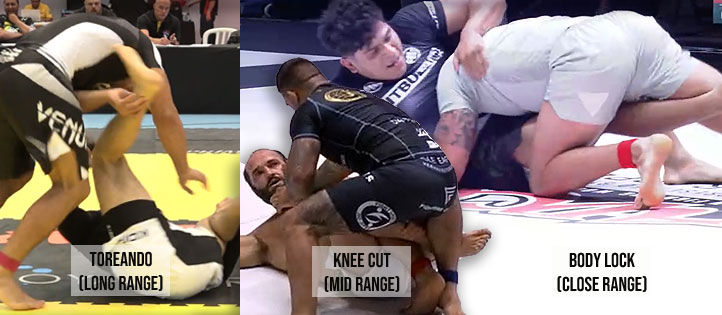
At BJJ Heroes, we’ve been tracking these metrics over the past 8 years and one of the stats that will stick out like a sore thumb is the big differences in a direct comparison between the passes shown in the aforementioned gi study, and this one. Whereas in the IBJJF analysis, we saw a majority of long and mid-distance passes conquered, in the ADCC assessment, close distance is king.
Graphic with 5 most utilized guard passes in ADCC:
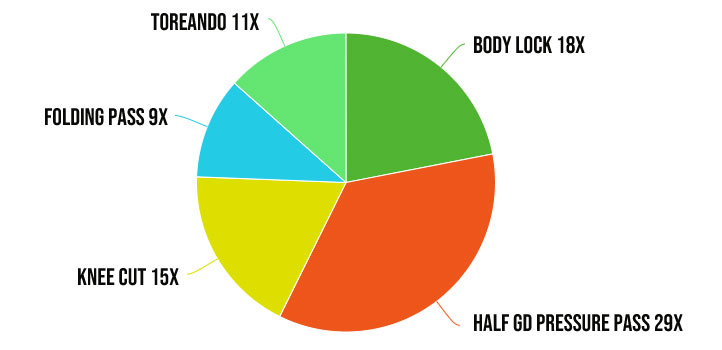
Close distance had over 2x the amount of success as the two most commonly long and mid-distance passes observed. The small caveat here is that the majority of these passes were registered in the upper weight classes, where pressure passing is a more natural approach, nevertheless, the body lock was still the most used guard pass in the 66-kilo division (3x over the numbers of knee-cuts, for example).
It is also important to point out that these numbers are an overall assessment of the data, and that the hegemony of either guard pass fluctuates a great deal each year depending on which athlete comes on top at the end of the show. It is for that reason that we address this metric both as a single technique and passing distances. Focussing on individual techniques will display big spikes each year in accordance with who is the dominant grappler. For example:
In 2022, we saw a record-breaking 11 body-lock (close distance) guard passes. These inflated numbers were greatly influenced by Nick Rodriguez’s outstanding performance, as he secured 7 of those 11 passes.
The same goes for the Toreando pass (long distance), it too saw a big spike (8) in 2015, but Felipe Pena alone accounted for half of those numbers.
Graphic displaying guard passes observed at the ADCC separated via distance:
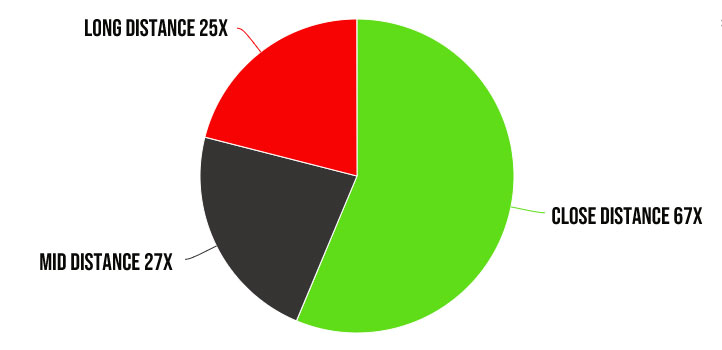
Regardless of which preferred passing technique is used by a particular player, the fact of the matter is that close-range passing is, overall, the most utilized method at the ADCC World Championships, which makes sense if we take into consideration how hard it is to control an athlete and keep his/her back on the mat without kimono grips, particularly at this level.
PASSING AS A MEANS TO AN END
Another interesting statistic when addressing the guard passing dynamics is how often a guard passing attempt leads to a back attack as a consequence of the bottom player’s defense.
We had seen this before in our gi guard passing study, where the data showed that “4 out of 10 back controls were conquered while attempting to pass the guard. Guard Pass Attempt > Guard Player Turtle’s > Back is Secured” (quote from the original piece here).
Regarding the ADCC ruleset, the numbers are identical to the previous analysis to a degree of similarity that may be as surprising to our readers as it was to us. 4.1 of every 10 back control that was conquered in the ADCC over the past four editions of the promotion’s World tournament, came from a guard pass attempt. As close as it gets to the 4/10 observed in the gi.
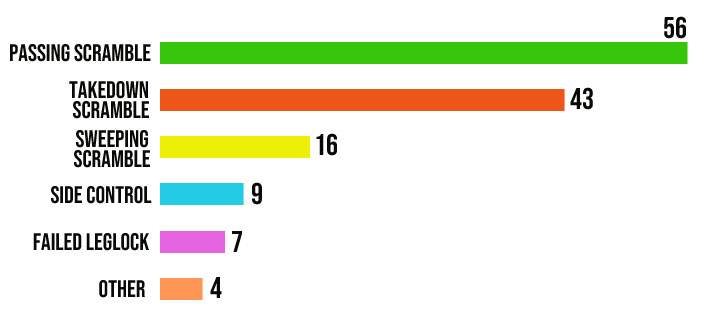
Taking into account that choking from the back control is the most utilized finish in the whole of jiu-jitsu, including the ADCC, it may be fair to say that guard passing is the most consequential style of fighting in grappling.
TOP GUARD PASSERS IN THE ADCC
Taking into consideration solely the matches held in the aforementioned 2015, 2017, 2019, and 2022 ADCC World Championships, the king of guard passing is none other than Yuri Simões of the Caio Terra Association. Much of Yuri’s incredible success came down to his 2015 and 2019 performances where the Brazilian competitor achieved none other than 11 of his total guard passes.
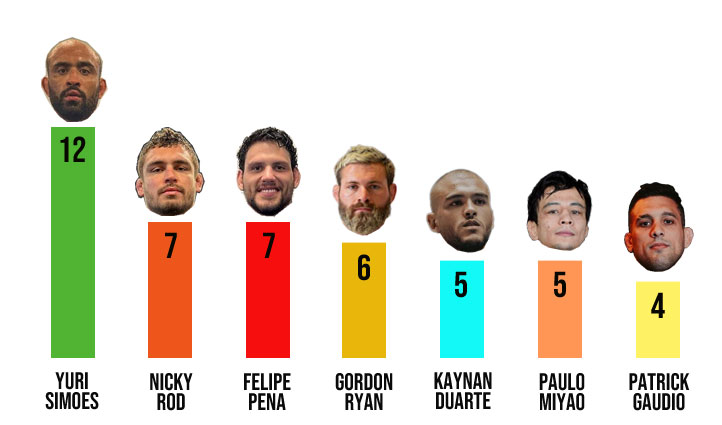
The #2 position of top guard passers in the ADCC ruleset is held by two competitors, namely Felipe “Preguiça” Pena (FP Team) and Nicky Rod (B Team), both being closely followed by Gordon Ryan (New Wave).
If we were to address guard passing as a means to back control, that element of the game was dominated by Felipe Pena (6 times) and Gordon Ryan (5 times). By far the most dominant back-takers within these specific dynamics.
Concluding this positional study, the stats lay out a different approach to successful passing in no-gi (or at least in the ADCC), when compared to the gi. Without the kimono grips, the scramble from the bottom player is likely too hard to contain by the passer, leading to a tighter approach. One metric, however, remains just as prevalent in both ruleset scenarios, the back-taking as a consequence of that aforementioned defensive scramble from the bottom player.
Much like observed in other jiu-jitsu studies performed by BJJ Heroes, contrary to common belief, the guard is not the most important factor at the highest level in the sport of grappling. The ability to be in the top position and not be swept or submitted does prove time and time again, to be the most successful method at this moment in time in the sport, if an athlete has top-level passing to boot, then the script is laid out for success.
















